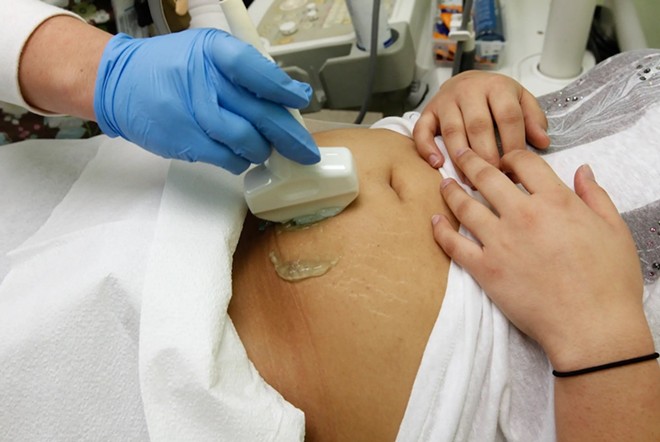
Texas Tribune
A girl will get a sonogram in an Austin clinic.
Join The Transient, The Texas Tribune’s every day publication that retains readers in control on probably the most important Texas information.
The speed of Texas girls who died due to being pregnant or childbirth rose sharply in 2020 and 2021 to the best because the state began monitoring maternal deaths in 2013. Even excluding deaths associated to COVID-19, the numbers had been worse than ordinary, reversing two years of progress in driving the maternal mortality charge downwards.
The Texas Maternal Mortality and Morbidity Overview Committee launched its report this month analyzing pregnancy-related deaths inside one yr of childbirth. The committee, which works on a a number of yr delay, intently analyzed circumstances from 2020.
The maternal mortality charge in 2020 was 27.7 deaths per 100,000 stay births, in comparison with 17.2 in 2019. With COVID-related deaths excluded, the speed was 24.2.
However the report exhibits, as soon as once more, that maternal mortality doesn’t affect each group equally. Black girls are about 2.5 instances extra more likely to die from being pregnant and childbirth than white girls. Each Black and Hispanic girls noticed a pointy enhance in pregnancy-related mortality between 2019 and 2020 — for Hispanic girls the speed elevated almost 9 factors to 22.2, and for Black girls greater than 11 factors to 39. However white girls truly noticed an enchancment, with the mortality charge dropping almost 3 factors to 16.1.
In 80% of those circumstances, the committee decided there was not less than some probability of saving the affected person’s life – a decline from 90% from the earlier report. 1 / 4 of ladies died as a result of infections, the most typical reason behind loss of life, adopted by cardiovascular circumstances, obstetric hemorrhage, embolisms and psychological well being circumstances.
For years, the committee’s first advice to enhance the state’s maternal mortality charge was the identical: permit new mothers to remain on Medicaid for 12 months after giving beginning, as a substitute of the 2 months Texas provided. In 2023, the Legislature accredited that extension.
Within the newest report, the highest suggestions are a extra normal name to enhance entry to complete well being care providers, in addition to prioritizing sources for pregnant and postpartum sufferers in public well being emergencies and fascinating Black communities to handle disparities.
Since the latest case evaluation is from 2020, it doesn’t replicate any affect from modifications to Texas’ abortion legal guidelines. In 2021, Texas banned nearly all abortions after about six weeks of being pregnant. In 2022, after the overturn of Roe v. Wade, the state banned nearly all abortions from the second of conception. The legislation permits for an abortion to save lots of the lifetime of the pregnant affected person, however dozens of ladies have come ahead with tales of medical care delayed or denied as a result of their docs had been confused or scared to deal with them.
State Rep. Donna Howard, a Democrat from Austin and chair of the Girls’s Well being Caucus, mentioned in a press release Wednesday that legislators ought to work “throughout partisan divides” to handle the rise in maternal mortality.
“Texas has huge sources at our disposal that may, and should, be leveraged to enhance well being outcomes for Texas mothers,” she mentioned.
Committee underneath fireplace
The maternal mortality committee, which was shaped with bipartisan help in 2013, has come underneath elevated scrutiny in the previous couple of years.
In 2022, the report was delayed, with state officers saying they wanted extra time to do an entire evaluation of 2019 circumstances. Advocates, in pushing for the report back to be launched, claimed Republican leaders, together with Gov. Greg Abbott, didn’t need it revealed forward of the autumn elections. It was launched in December of that yr, and confirmed most of the identical challenges mirrored on this newer report.
In the course of the 2023 legislative session, lawmakers added further positions to the committee, together with two group member spots to interchange the prevailing advocate position. Whereas the earlier place was crammed by a Black girl who herself skilled beginning trauma, each of the brand new spots had been crammed by docs. The place reserved for a rural group member went to an anti-abortion OB-GYN from San Antonio over a labor and supply nurse from the Rio Grande Valley, The Texas Tribune revealed in August.
Moreover, the Legislature appropriated $6 million in 2023 to create a brand new state-level monitoring program for maternal deaths — and take away Texas from the Facilities for Illness Management’s monitoring program in consequence.
The report mentioned the brand new system will permit “for extra environment friendly and timelier case identification.” However at a committee assembly in June, chair Dr. Carla Ortique mentioned taking part within the nationwide system alongside nearly all different states was key to “effectively and successfully” reviewing circumstances. She mentioned on the assembly that it was unclear whether or not the laws would permit for them to run the state and federal programs concurrently, however she felt it was essential for such a giant state to proceed to contribute to the nationwide system.
Texas Well being and Human Companies Fee additionally not too long ago declined to take part in a federal maternal well being program that will have offered funding and technical help, Howard mentioned in a press release. The company mentioned it could want legislative route and appropriations to have the ability to take part, she mentioned.
This text initially appeared within the Texas Tribune.
The Texas Tribune is a member-supported, nonpartisan newsroom informing and fascinating Texans on state politics and coverage. Be taught extra at texastribune.org.
Subscribe to SA Present newsletters.
Comply with us: Apple Information | Google Information | NewsBreak | Reddit | Instagram | Fb | Twitter| Or join our RSS Feed





